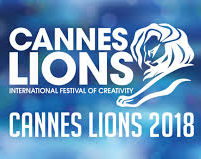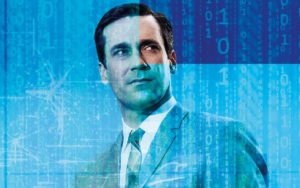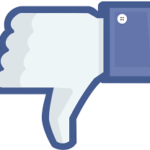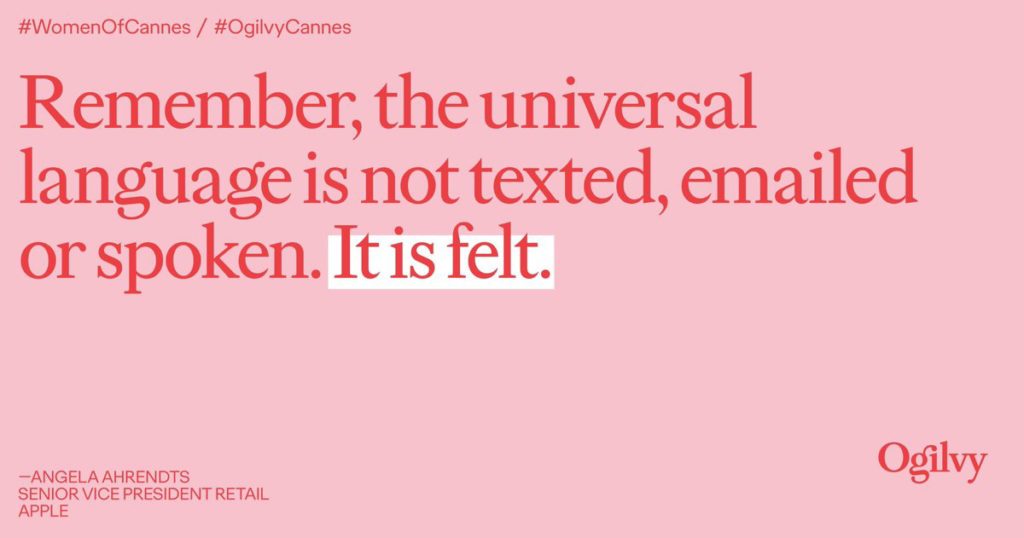… including links to our favorites ads
(with thanks to staffers Catarina Conti and Silvia Di Prospero)
“Yikes, it’s back-to-business this year! I mean, man, the driveway at the Carlton hotel was noticeably easier to navigate, that crowd palpably thinner. And people were going to bed at 11 — and taking meetings at nine in the morning! Even the Spotify party was surprisingly easy to get into and navigate! This is an industry that’s taken a few punches. Even the sex workers had less to do. I asked one how business was compared with last year and she said “C’est trop tranquille” (too quiet)” – a quote from an executive with a major ad agency
[ for Part 2 click here ]
31 July 2018 (Serifos, Greece) – Last month our team made its pilgrimage to the annual Cannes advertising conference. Or to give it its full honorific, the Cannes Lions International Festival of Creativity 2018. The gist of the quote I used above … from a long-time ad agency friend … was, in short, that this was the Diet Coke of Cannes Lions: slimmer, caffeinated, slightly less bad for you. All the people who should not have been there, were not here. No “extras”. The Carlton driveway may have been empty (the Carlton is usually the mega-spot for meetings) but all the panels and sessions at the main event were still very well attended. “Fire and Fury” author Michael Wolff in conversation with adman Jeff Goodby was full to overflowing, with people sitting in the aisles.
Cannes Lions is what I like to call “The Conference of the World’s Attention Merchants”. Because over the last decade, the festival has evolved to include not only more brand clients but also, due to media fragmentation which has led to the change of some and the birth of others, an expansion into tech companies, social media platforms, consultancies, entertainment and media companies — essentially the entire attention ecosystem.
In the last year, the industry has undergone a major transformation, and Cannes Lions with it. The event was knocked down to five days this year (from its usual eight days). My favorite line on the reduction to five days: “Listen, three days is really all you need. Otherwise, you risk starting to believe this is real life”. Plus there were fewer awards, fewer yachts, and clearly fewer people (the massive advertising firm WPP usually brings 1,100 people to staff the event but this year “only” brought 500). There had been a feeling in the last year or two that Cannes Lions had “lost the plot” with its extravagant partying, high spending and sprawl. So this year, it was a bit smaller and more toned down, part of a long overdue “streamline and focus” initiative by the organizers which included no free event tee-shirts (Sad!)
Note: my readership for these posts is eclectic: AI apostles, “cyber war” mavens, media industry gurus, the mobile technology crowd, and litigation support personnel. In this post I will focus on my advertising/media industry take-aways, and devote Part 2 to the extensive discussions we had on the General Data Protection Regulation (GDPR).
My big take-away is pretty much the same every year: people keep underestimating the power of marketing. A lot of what we believe does not come from direct experience and does not come from a knowledge of facts, but comes from the repeatedly hammering beat of talking points and iconic images. Data scientist Francois Chollet of Google has brought the point home for many of us who work with artificial intelligence:
I see this power of marketing especially striking in deep learning, a field where almost everyone has joined in the past 3+ years … but few have any real experience (especially compared to the field’s overall complexity), and where there are few established facts. So what you have is lots and lots of strong opinions, all generated from those well-circulated talking points floating around the web.
That’s the thing. These days, conversations overheard at this international celebration of creativity are just as likely to be about machine learning and programmatic ad technology as they are about imagination and storytelling. There is the stark reality that the advertising industry has been fundamentally turned upside down in the digital age.
And as I have noted before about Cannes Lions (and much like the Mobile World Congress), when you have the brain power in attendance at an event like this you cannot help but have some “deep dive” sessions, and deep conversations … at dinner, the bar, on the beach … about the cultural aspects of media, politics and social interactions vis-a-vis digital technology … subjects you tend not to address at other conferences which are too trade-focused. So you need to grab this time given these wonderous communication channels.
I relish “Big Picture” chats … even the over-the-top areas of abstract thought and theory … because they most definitely affect and impact not only my commercial ventures but my intellectual ventures, too. So herein some “Big Picture” ideas and themes, in no particular order.
ALAS, DON DRAPER IS (ALMOST) DEAD
Yes. Advertising, once a creative industry, is now a data-driven business reliant on algorithms. The implications are deeply sinister – not only for the consumer but for democracy itself. And that’s the BIG story these days so just a few thoughts.
And the advertising industry has been enthralled of late by a prophet of its imminent demise. Scott Galloway is a professor at New York University’s Stern School of Business, and founder of a marketing consultancy. He has a series of YouTube videos on the power of Google and Facebook, a talk entitled “The Death of the Advertising-Industrial Complex”, etc.
It wasn’t all that long ago that it was possible to identify somewhere called “Adland” on a map. In New York, advertising agencies clustered on or around Madison Avenue, near the big department stores. In London, the action was in Soho, among the film and TV production houses. The industry was a small world, with all the collegiality and parochialism that implies. In both cities, ad agencies are now dispersed randomly around town, as if an earthquake had destroyed their habitat, forcing them to scatter in different directions. Once so sure of their place in the world, they now seem a little lost.
The earthquake, of course, was the internet, and the subsequent seizure of the ad business by technology companies. Between them, Google, Apple, Facebook and Amazon (about whom Galloway has written an acclaimed, critical book, The Four, which I highly recommend), have transformed advertising’s terms of trade. Clients pour billions into a digital ecosystem that revolves around Google and Facebook in particular. The ad industry, run by people who pride themselves on creativity, is being displaced by the ad business, which prides itself on efficiency. Clients are spending less on the kind of entertaining, seductive, fame-generating campaigns in which ad agencies specialise, and more on the ads that flash and wink on your smartphone screen.
Note: there are some brilliant exceptions and I will close this post with links to my favorite ads.
The ad industry views itself as a field of applied artistry, a next-door neighbor to the entertainment industry. Though it often fails, it aspires to surprise, charm, move and delight people on behalf of its clients. The ad business is obsessed with data science, and distrusts the messy stuff of story, image and idea. The ad industry thinks of itself as the custodian of a brand’s meaning in popular culture. The ad business could not care less about such fluff. Said one ad maven in Cannes this year:
We seek to identify the precise moment that a consumer needs something so that it can trigger a sale. Shopping, on this model, is essentially an engineering problem to which a satisfyingly logical solution has finally been found.
The ad business is largely automated. Clients only have to decide how many people they want to reach, and how much they want to spend; algorithms do the rest. In the milliseconds before a page loads on to your screen, a virtual auction takes place. Advertisers bid for the chance to place their client’s ad on it, based on data about your online behavior: where you live, whether you’re young or old, recently shopped for shoes or searched for a car brand. The advertiser might create multiple ads and serve different executions to different slices of its audience. Some companies, such as Cambridge Analytica, claimed to be able to target personality types using this method. The more valuable your particular profile is to the advertiser, the higher price its algorithm will pay the publisher to get an ad in front of your eyes. In this way, every scintilla of attention is transformed into money.
But … it ain’t all gravy. The ad business has problems. Algorithms are poor at making judgements that seem obvious to humans, like whether or not a soap brand will be happy having its ads run next to an Isis recruitment video. Consumers have proved ungrateful for the increased “relevance” of the ads that pop up on their screens, partly because so many of them are bafflingly irrelevant. Tiring of the aggressiveness with which online ads insert themselves between them and the content they wish to see, more and more people are using ad-blockers to combat what they regard as infestation.
And so clients have even started to question the ad business’s claim to efficiency. Rory Sutherland, vice-chairman of Ogilvy & Mather, and the ad industry’s most vigorous defender, sees a backlash:
One reason I’m not predicting the death of advertising any time soon is that you can see how important it is in nature. A flower is basically a weed with an advertising budget.
Sutherland believes that something in the mindset of technologists makes it hard for them to see or admit the value of advertising. The nerds are sceptical of advertising, marketing and sales because “they seem superficial and irrational. But advertising matters because it works. It works on nerds, and it works on you.” Engineers tend to conceive of advertising – insofar as they think about it at all – as a mere conduit for information about the product, which in their mind should speak for itself, without the superfluous operating system of a brand. Sutherland argues that efficiency is overrated, and that excess and superfluity are weapons that marketers surrender at their peril.
The money/data model I described above is a very simplified version of a dizzyingly complex system whose details few can fathom, involving multiple companies taking multiple fees. So for the moment, let me leave it there.
But stepping back a bit, and looking at the whole picture, I do “get” the doctrine of micro-targeting. However, it has a major lacuna: it is only by being visible to everyone at once that advertising can perform its most valuable role: shaping the cultural meaning of a brand. The very act of advertising in public tends to make a brand more trusted, since people can see it has a social reputation to maintain. I have read study after study after study that consistently found that ads in broadcast media are taken more seriously than online ads: one reason for this is that people can see that other people can see them too. Mark Zuckerberg certainly gets it. Seeking to restore trust in Facebook in the wake of the Cambridge Analytica scandal, why in hell do you think he ran full-page ads … in newspapers?!
THE DUOPOLY BACKLASH … AND GAMING THE SYSTEM
Just a few years ago, Facebook and Google were the toast of the town. Google has long used Cannes to butter up creatives (and media buyers and marketers), and Facebook has grown its presence alongside Google.
This year, both took a beating as more calls come to break up the duopoly’s power – and Facebook gets grief over its data scandals and role in electing Donald Trump. The days of connecting the world as an aspirational dream have hit the hard reality of the use of the platforms to divide people, while the platforms themselves have run roughshod over entire industries to their own benefit.
But while anxiety around the duopoly was at an all-time high last year (see my analysis of last year’s Cannes Lions here), this year it was two or three times higher. And while the Facebook-Cambridge Analytica imbroglio and brand safety scares on YouTube did take their toll, eMarketer estimates the two companies will still capture a combined 56.8 percent of U.S. digital advertising dollars in 2018, down slightly from 58.5 percent last year.
It’s not just advertisers who are anxious. Audiences (or “consumers,” if you will) are too. The agency Hearts & Science released a report along with the Center for Humane Technology during Cannes about our device addiction and how to ethically game social media algorithms. We get a dopamine rush from the likes meted out to us; we get fake news confirming our biases. We get Donald Trump threatening to nuke North Korea off the planet one day and saluting Kim Jong-un’s goons the next.
ARTIFICIAL INTELLIGENCE
Just a few snips because machine learning and AI were huge themes this year and hit many sessions.
Among various keynote speeches and discussions that ensued during the opening day on Monday, “Accelerating Creativity in the Age of AI” was one of the best. It brought together the likes of Adobe’s Vice President of Design, Jamie Myrold, artist Mario Klingemann and Pentagram partner Natasha Jen who kicked off an intriguing discussion about all the ways the rise of artificial intelligence can actually aid in the creative process. The session delved into various aspects like how artificial intelligence will impact creativity and the human aspect of the creative process. Said Jen to kick it off:
Machine learning is very much integrated into our lives in so many ways that we don’t even know it. Deep-learning has begun to emerge as the next wave. AI is further going to increase efficiency remarkably, and productivity is also going to increase. We will be able to materialize our ideas much faster.
Klingemann opined that we can reap the benefits of machine-learning in an efficient manner, that today we have more and more data which is like a wealth. We can utilize machine-learning to pull out things and get truth out of the data. But he said:
I fear sometimes that we’re not as creative as we think. We need to have impulses coming out that trigger something in us. With machine learning, we can have the machine give us these impulses based on what it thinks might be relevant to us and then augment it. With these we can almost goldmine the past, add something new to them and give it a new twist.
Myrold also shed light on the role of creative AI: does it have the potential of democratizing creativity? She said:
Democratization of tools is already happening. You have access to creative tools like Instagram and Facebook without even knowing that it is assisted by AI.
Jen contended that the language around new technology is always so nuanced that you have to look at the historical trajectory as well as the contemporary landscape.
An interesting point of discussion was also around the authorship of the creative work: who does it lie with? Is it human beings or the tools? Both Jen and Klingemann feel that while tools are there, it’s still humans making the decisions. Jen pointed out that over time we will see more and more augmented reality (AR) functions available, which will go beyond the putting a filter on your face. But the panel was agreed: a lot more really practical AR applications are on the way. Discovering of that knowledge will be really exciting.
BRANDS ARE STARTING TO VISUALLY DISAPPEAR, SONIC BRANDING IS THE FUTURE
There was a panel of industry experts in audio that spoke about how voice will change the world. All the statistics claim how huge voice is going to be, but is that really what the industry is experiencing? One in six U.S. households have voice assistants, so it’s coming hard and fast. As advertising agencies (and fans), you need to think about this and how to put your brands forward in this new space. McCann London’s managing director Sheryl Marjoram said we all have a voice and that companies and brands shouldn’t exclude the older generation: “Voice doesn’t care if you’re six or 106”.
And this isn’t going to have an adoption rate like tech. There isn’t going to be the normal awkward start were people get anxious or intimidated, it’s not going to exclude and will welcome in everybody. A third of the people who have smartphones are 55 and over. It’s not just for the kids. However, brands are starting to visually disappear, and many on the panel believes that a “sonic identifier” will really help brands to continue to capture to customer experience. There are so many technologies now that are voice first, voice only or sound. If brands don’t have an identifier, if they don’t have a way to carry people through those customer experiences, then they are not going to get credit for those things. The engagement levels go up when you use sound in terms of the customer experiences.
And voice offers brands a sweet spot. Voice is an opportunity for brands to get in there and figure out what gift they are going to give the world, how are they going to turn up and what can they do that is really different to give real meaning to customer service. Brands can really express themselves with sonic branding. The power of the emotion voice can offer from the music or feeling or sound. Said Marjoram:
It’s a really powerful sense, and we should really be using that when we think about brand marketing. The problem is talking is very disruptive and most people who are approaching voice, are approaching it the wrong way. You can’t just think about the human voice. You need to score the customer experience, not only for the brands to get credit, but for these experiences to be really next level intuitive that you clearly know emotionally what the customer wants.
COMING IN PART 2: THE GDPR
Before I leave you with a few of my favorite ads, a quick word about Part 2.
The arrival of the General Data Protection Regulation (GDPR) has led some U.S. vendors like Verve and Drawbridge to pull out of Europe entirely to avoid the cost of getting their businesses GDPR-compliant, and avoid any risks should they fail to do so. Most ad tech executives are pretty candid in their predictions that other noncompliant U.S. vendors will also be forced to leave Europe in the coming months. And many vendors have unveiled their “two sites” approach: one for U.S. consumers, and the other for rest of the world.
Some of the discussions at Cannes were informative because we had a bevy of e-discovery attorneys present, plus representatives from two e-discovery vendors (at my invitation). And one of the e-discovery lawyers nailed it. He said:
Look, it’s going to be an iterative process, and this GDPR compliance stuff will be a marathon and a theme far into the future. There will be many, many, many lessons learned. But I suspect the regulators will go for the the low-hanging fruit like audits of data processing activities. That’s the real easy stuff.
And … voila! A few weeks ago both the Dutch and the French data protection authorities announced (in almost identical language) they would conduct “[GDPR] audits of registers of data processing activities at selected companies”.
Yes, all kinds of chats and presentations about GDPR “consent” and the proper handling of “third-party data”. But the most relevant (and certainly the most important issue) were the discussions about the transparent algorithmic decision-making provisions of the regulation. The GDPR requires data controllers using algorithms for automated decision-making to explain the logic of that decision-making. Tucked away in recital 71 of the GDPR there is even a requirement to use “appropriate mathematical or statistical procedures” to avoid or reduce risk resulting from errors or inaccuracies.
I will go into more detail in Part 2. Right now, to close out Part 1, my favorite ads:
The footage below is absolutely heartbreaking to watch. Developed by the International Committee of the Red Cross, it deservedly won a Grand Prix Film award in the “Excellence in Craft” category. The nearly two minute film, which takes place in a war torn country, states, “No hospitals. No hope.” It then states that healthcare workers are attacked every day in war zones, with a plea to save these workers and a tag of “Healthcare is #NotATarget” :
And lastly, an audio, not a video.
President John F. Kennedy never got a chance to deliver his 1963 speech at the Dallas Trade Mart, where he hoped to address America’s role in the world and the principles that must guide the nation. Kennedy was assassinated en route to the venue, and those who arrived hoping to hear him speak instead were some of the first to learn of his death.
Earlier this year, U.K. news outlet The Times and Irish agency Rothco unveiled a digital recreation of the speech he had prepared. The sound engineering required was simply incredible. They were able to connect the dots from a data perspective and a technology perspective. To build the speech, the production team began with recordings from 831 speeches and interviews, resulting in 116,000 sound units. The wide array of sound qualities and background noises made it an especially difficult challenge to create a seamless final product.
It is called “JFK Unsilenced” and while it sets a new bar for audio restoration and engineering, it also posed plenty of ethical questions about how this technology might be used moving forward. Many said “just because technology can do something, should it?” But the researchers noted the potential of this approach which is already being used to improve the voice tools available to ALS sufferers unable to speak.
Here is a short video of how they did it, and a recording of the end result:
And the final word … from my sponsor:








One Reply to “Cannes Lions 2018: Don Draper is dead, media convergence goes high-speed … and the GDPR takes center stage [1 of 2]”